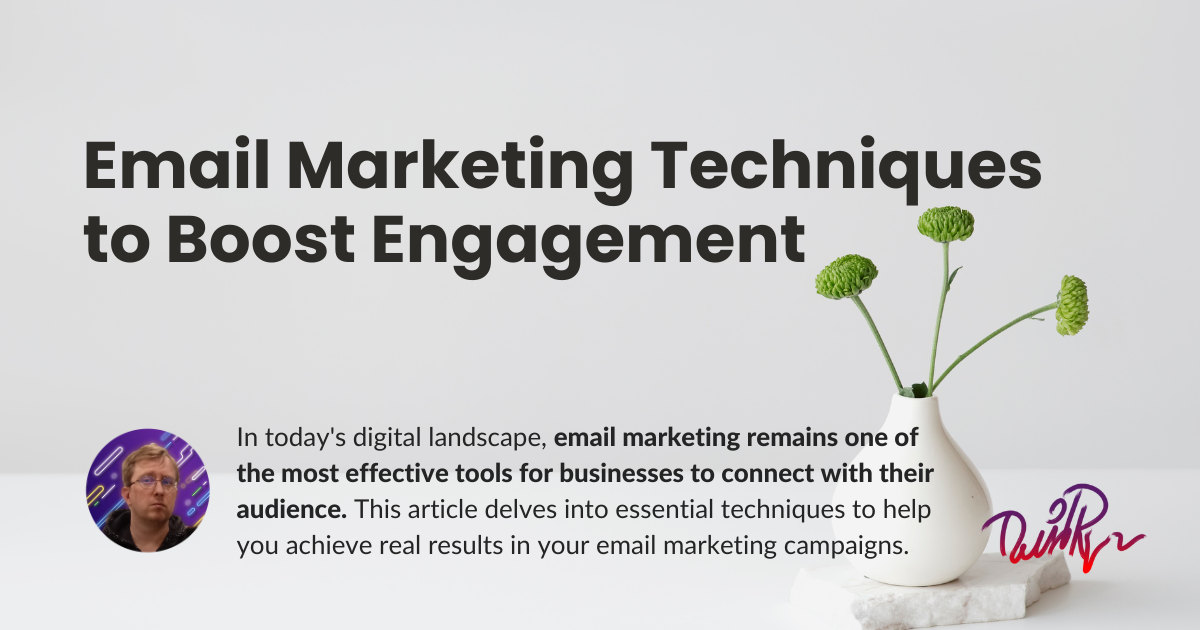Email marketing is one of the most powerful tools in digital marketing, and it can be incredibly effective if used strategically. When done right, email marketing can help businesses stay connected with their audience, deliver valuable content, and increase sales. In this article, we will dive into key email marketing techniques that focus on building a strategic approach to boost customer engagement.

Understanding Your Audience
To build a successful email marketing strategy, it’s crucial to start with a clear understanding of your audience. Knowing your audience allows you to tailor your messages so they resonate more effectively. This is a core principle of effective Email Marketing Techniques. One way to do this is by using segmentation and targeting.
Segmentation, a key element of Email Marketing Techniques, means dividing your email list into smaller groups based on characteristics like behavior, demographics, or interests. This helps you send relevant emails to each group, which can lead to higher open and click-through rates. For example, if a clothing store has both teenage and adult customers, it could segment the list based on age so that younger customers receive trendier updates, while older customers receive more classic styles. This targeted approach is a hallmark of successful Email Marketing Techniques.
Personalization goes hand in hand with segmentation and is a critical aspect of Email Marketing Techniques. By using information you know about your audience, you can personalize the emails to feel more connected to the recipient. For instance, including the customer’s name in the email greeting or recommending products based on past purchases can make the email feel more relevant.
Another way to understand your audience, and thus improve your Email Marketing Techniques, is by creating buyer personas. These personas represent the ideal types of customers you’re trying to reach and help you shape the content and tone of your emails. A buyer persona might include details like the person’s goals, interests, and common challenges, which you can use to make your emails more engaging.
Crafting Compelling Content
One of the most important aspects of effective email marketing techniques is the content itself. When customers open an email, they want to find something useful or interesting. Creating value-driven content ensures that each email provides something of worth, rather than just a sales pitch. For example, if you’re running a travel agency, you could send out emails with travel tips, destination highlights, or guides that provide helpful information alongside promotional offers. This is a core principle of successful email marketing techniques.
Using storytelling is another effective email marketing technique that can make your emails more memorable and engaging. Telling a story—whether it’s about your brand, a customer’s experience, or an inspiring journey related to your product—can help you connect with your audience on an emotional level. People are naturally drawn to stories, so adding a storytelling element to your emails can keep readers interested.
Finally, don’t underestimate the power of a great subject line. Subject lines are the first thing your audience sees, and they play a major role in getting people to open the email. A good subject line is short, clear, and grabs attention without being too pushy. For example, a subject line like “Your Weekly Deals Are Here!” is likely to catch a subscriber’s eye without feeling too aggressive. Optimizing subject lines is a crucial email marketing technique for improving open rates.
Optimizing Email Design and Layout
Having well-designed emails is essential for keeping your readers engaged. Since many people open emails on their phones, mobile optimization is a top priority. Make sure the layout and images look good on both mobile and desktop screens. For instance, using a single-column layout with larger text can help make emails easier to read on a small screen.
Another useful design technique is visual hierarchy. This means organizing the content in a way that guides the reader’s eye naturally. By using larger fonts for headers, bold text for important information, and images to break up sections, you can make emails easier to read and more visually appealing.
Adding interactive content like polls, GIFs, or videos can also boost engagement. Interactive elements create a dynamic experience that makes your email stand out. For example, you could add a GIF to showcase a new product or use a poll to gather customer feedback.
Effective Email Marketing Techniques: Timing, Frequency, and Triggers
Effective email marketing techniques rely heavily on understanding timing. Finding the right time to send emails can help you reach your audience when they’re most likely to be online and ready to engage. This often depends on data specific to your audience, so consider testing different times and keeping track of when emails get the best response.
Another key factor among email marketing techniques is frequency. Sending too many emails can overwhelm your audience, causing them to unsubscribe or ignore future messages. It’s important to find a balance by setting a regular schedule that offers value without becoming annoying. For example, a weekly newsletter can keep customers engaged, while daily emails might feel excessive unless your audience has opted in for that.
Triggered emails are also a great tool for boosting engagement and represent a powerful set of email marketing techniques. These are emails that automatically go out based on a specific user action, like signing up for an account or abandoning a shopping cart. Because triggered emails are highly relevant, they often get better engagement rates. A welcome email series for new subscribers or a cart reminder for those who didn’t complete their purchase can help you nurture leads and drive conversions.
A/B Testing and Analytics for Continuous Improvement
To truly understand what works, A/B testing is essential. This involves sending two different versions of an email to see which performs better. Key elements you can test include subject lines, visuals, and calls-to-action. For example, you might test two subject lines, such as “Last Chance to Save 20%” versus “Get 20% Off Now!” to see which one gets more opens.
Using analytics allows you to track the success of each campaign. Important metrics to follow include open rates, click-through rates, and conversion rates. These insights can help you identify areas to improve and refine your strategy over time.
After analyzing the results, use iterative improvements to make small changes that bring your strategy closer to optimal results. If you find that emails with certain types of visuals get more engagement, you can start using similar images in future campaigns.
Engaging Subscribers Beyond the Inbox
Email marketing doesn’t have to stay within the inbox. Creating omnichannel connections helps strengthen your relationship with subscribers by reaching them across multiple platforms. For instance, you can promote your emails on social media or use SMS reminders to alert customers about important emails.
Encouraging user-generated content can also boost engagement. By asking subscribers to share their own experiences, feedback, or photos with your product, you create a more interactive and community-oriented experience. For instance, you could run a photo contest where customers share pictures of themselves using your product, which not only boosts engagement but also builds brand loyalty.
Finally, building a feedback loop helps you understand what your audience enjoys or dislikes about your emails. Asking for feedback directly from subscribers gives you valuable insights into how to improve your future campaigns. For example, you could include a short survey at the end of an email, asking readers to rate the content or suggest topics for future emails.
Concluding Thoughts on Email Marketing Techniques
Email marketing is more than just a way to send promotions; it’s a strategic tool that can help you engage and build lasting relationships with your audience. By understanding your audience, crafting valuable content, optimizing email design, and using data to refine your approach, you can create emails that resonate with your subscribers and drive real results. Start implementing these strategies to see how a more strategic approach to email marketing can make a positive difference in your engagement levels.
